Uncertainty loomed: on the horizon, where the skies above Bull Island appeared dark and threatening, and on our skiff, where the engine over-revved when we tried to plane off. Fortunately, the motor issue resolved, and we continued our cruise to undertake the first documented alligator survey on Bull Island since 2001. We would be fortunate that the rains would hold off until sometime in the early morning. This would be a night survey, and we made it to the island before 8PM.
Our group was organized and led by Ben Ashworth, a wildlife refuge specialist with Cape Romain National Wildlife Refuge of the US Fish and Wildlife Service (USFWS). Three other USFWS staff were present: Nicole Rankin, a coastal ecologist; Jean Ruble, an administrative officer with the Tennessee NWR; and Thomas Rainwater, a contaminant specialist. I was the lone non-USFWS person along. I had worked with both Dan and Thomas on building the loggerhead hatcheries on Cape Island in April. 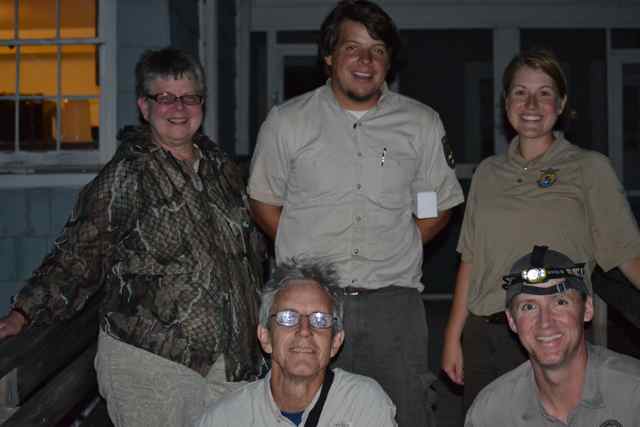
On the back ramp of the Dominick House. Standing, from left : Ruble, Ashworth, Rankin; below: Raynor, Rainwater.
We offloaded our gear and carried it by vehicle to the Dominick House, where we would sleep after the survey’s completion before heading back to the mainland. After we ate a meal around the kitchen table, the detailed planning for the night began. Earlier I had noticed a file folder with past survey notes that Dan brought aboard the skiff, and these were referenced during the formulation of the method for this survey. The knowledge and skills of Dan, Nicole, and Thomas hammered out what would not just be a one-time plan, but an ongoing survey to be conducted periodically.
I had learned on Cape Island in April that Thomas brought some unique skills and experience to the table – his thesis work was on crocodilians. His studies included fieldwork with both freshwater and saltwater crocodiles in Belize. He had worked on similar night crocodilian surveys using powerful lights to search out reptiles. He was currently working with Phillip Wilkinson at Yawkey Wildlife Center in surveying alligator nesting, including trapping and sampling the female nesters, and had spent his day before joining us in the wetlands of Yawkey.
After nine, we headed out into the Bull Island night. 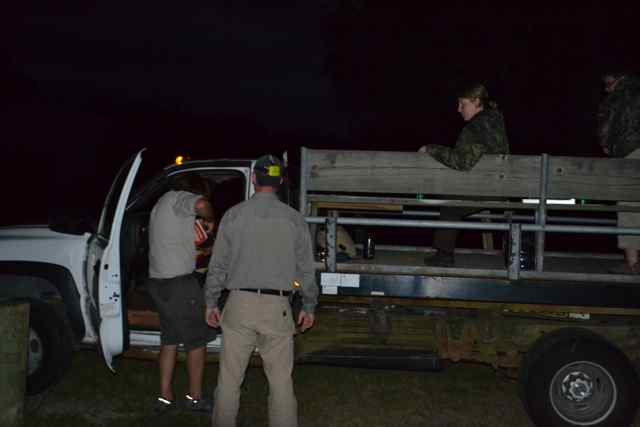 We used as our survey vehicle a modified truck, the bed fitted with benches and railings. Dan drove while the rest of the group climbed up to our high perch. Nicole assumed the role of scribe, organizing and recording the data given to her by Dan and Thomas.
We used as our survey vehicle a modified truck, the bed fitted with benches and railings. Dan drove while the rest of the group climbed up to our high perch. Nicole assumed the role of scribe, organizing and recording the data given to her by Dan and Thomas. 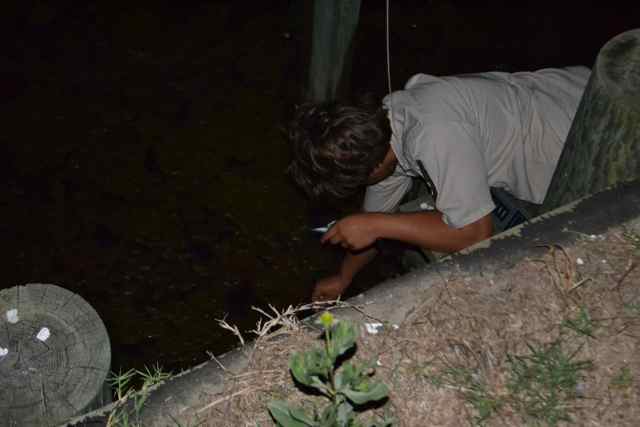 Besides driving, Dan also jumped out at each survey stop for samples: air temp, water temp, water salinity. From above, we recorded other data: wind speed, sky conditions (clouds, moon), and water surface conditions. Each stop was identified with place descriptions and GPS coordinates. Thomas was the spotter: shining the spotlight (750,000 candle power), and counting alligators, at times just by the eyes’ reflection. But he did more, estimating each gator’s length (those within range) with his trained eye. It was an impressive feat, and when we discussed variables to the method I commented that the experience and skill of the spotter was critical.
Besides driving, Dan also jumped out at each survey stop for samples: air temp, water temp, water salinity. From above, we recorded other data: wind speed, sky conditions (clouds, moon), and water surface conditions. Each stop was identified with place descriptions and GPS coordinates. Thomas was the spotter: shining the spotlight (750,000 candle power), and counting alligators, at times just by the eyes’ reflection. But he did more, estimating each gator’s length (those within range) with his trained eye. It was an impressive feat, and when we discussed variables to the method I commented that the experience and skill of the spotter was critical.
Dan took us to our first stop at the dike of Upper Summerhouse Pond, a view both into the impoundment and to the west toward the marsh and mainland. The power of the spotlight became apparent, picking out eyes in the distance. I wondered at its range later, and Thomas estimated one of the alligators was spotted out at about two hundred yards. Dan had planned a pre-arranged route, and we traveled along the roads, making numerous stops at the various impoundments on the island. We were blessed with a steady southwest breeze, helping to disperse the mosquitoes, though in sheltered areas they found us. Nicole and Jean were prepared with bug jackets, and occasionally they would pull up the net hoods for protection.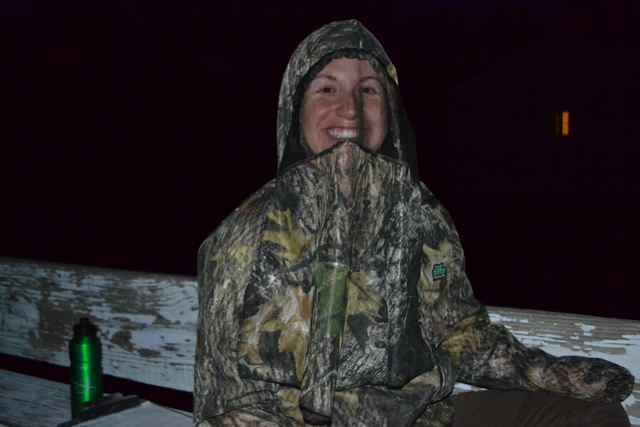 I wore long sleeves, a hat pulled around my ears, and the unusual precaution of repellent on my face and hands. Thomas was seasoned by his fieldwork experience, and the conditions were most likely tame compared to a usual day at Yawkey. And Dan, energetic, youthful, and wearing shorts and a short sleeved shirt, seemed immune.
I wore long sleeves, a hat pulled around my ears, and the unusual precaution of repellent on my face and hands. Thomas was seasoned by his fieldwork experience, and the conditions were most likely tame compared to a usual day at Yawkey. And Dan, energetic, youthful, and wearing shorts and a short sleeved shirt, seemed immune.
This vehicle has been used for special events, such as island safaris, i.e. the Rudy Mancke annual tours. Thomas described the survey as the most comfortable he had ever experienced; he recounted one paddling in a canoe. Driving through the maritime forest canopy at night was spectacular, with the headlights lighting up the lush subtropical vegetation. WIth the darkness and dense growth the ravages of Hurricane Hugo to this barrier island forest seemed in the distant past. Our lights revealed several deer, a couple of raccoons, and what appeared a great horned owl flying along Big Pond Road ahead of us.
I was surprised by one survey area on Dan’s route – we actually saw a number of gators in a small ditch along Big Pond Road. I did recall after the fact seeing a group of alligators basking along the road earlier this year, and they clearly had come from this wetland. We were anticipating arriving at Alligator Alley, and what has always seemed to be the mecca for alligators on the island, Pool #2. I had mounted my camera on a tripod and prepared for taking some photos on this night, an undertaking a bit outside of my photographic experience.
A number of alligators appeared in the spotlight at the east side of Pool #2. When we arrived at the middle water control structure, and Thomas lit up the swimming pool sized body of open water, it was “showtime” – dozens of alligator heads were exposed on the surface. 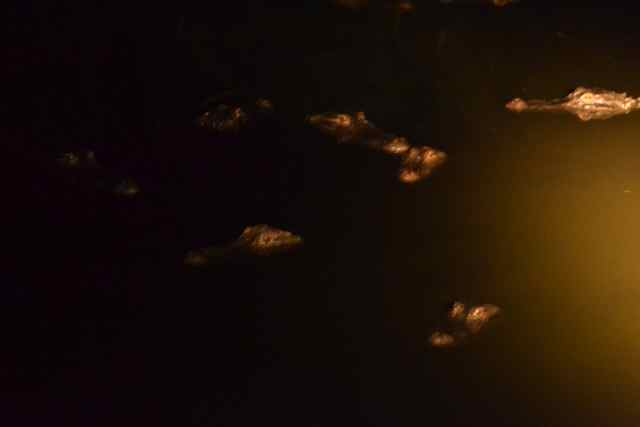 The count in this small pool actually was sixty-six. Even Dan may have been a bit spooked when he climbed down the dike’s slope to get his water sample, and a large number of the alligators rocketed away from his presence, roiling the water extensively. We talked about why the pool had this density, and how they could all thrive there.
The count in this small pool actually was sixty-six. Even Dan may have been a bit spooked when he climbed down the dike’s slope to get his water sample, and a large number of the alligators rocketed away from his presence, roiling the water extensively. We talked about why the pool had this density, and how they could all thrive there. 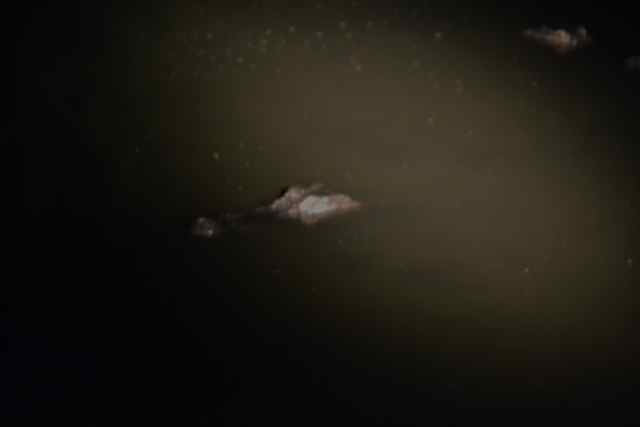 Thomas suggested two important factors: the pool’s low salinity, and the water control structure creating a funneled flow of food from the much larger and more saline Jacks Creek impoundment on the other side of the dike.
Thomas suggested two important factors: the pool’s low salinity, and the water control structure creating a funneled flow of food from the much larger and more saline Jacks Creek impoundment on the other side of the dike.
We continued our circuit of Jacks Creek, and the high salinity readings were coupled with a small count of gator sightings. On the east side of Jacks Creek, we drove over the secondary dike that now is the last barrier between the impoundment and a reuniting with the ocean as occurred after Hurricane Hugo. The recent high tides had filled the section between the beach and the dike with water, and looking across the narrow beach we could see the surf breaking.
Finishing Jacks Creek, we also took a look at New Pond, and Moccasin Pond. That marked the end of our survey, and we headed for the Dominick House to rest before leaving at daybreak. There was a final tally of 168 alligators. This number accounted for just a percentage of the total on the island. A formula was created in the past to estimate the island’s population, and this survey will be used with the results of future counts to get a total. The time of this survey occurred during the alligator nesting season, and more young alligators in the next few months will be hatching from their nests and exploring the impoundments of this barrier island so exquisitely suited for these crocodilians.
Sounds like a great night on Bull Island, and for a very worthy endeavor. Put me on the side using bug spray though.
hey bob,
be sure to let us know about the extrapolated number of gators after that calculation is made. i was amazed at the low number that you all counted even though i guess its a bunch to be seen at night.
we should have a lottery for the person guessing closest to the professional calculation.
i am guessing 421
I will post that estimated number when the work is done. Not wanting to bias anything, mind you, but I think your number is low, quite low. We shall see.
Can’t image what survival atnavdage being orange would confer on an alligator…but it might make it easier on those of us who like to spot them in the water. :)There’s not a lot of clay in FL so I can imagine this isn’t that common a sight. But that’s sure what it looked like to me, before I even read the text of your post.
Really enjoyed the write-up and reminiscing our adventures! Thanks so much for coming out with us, we hope to do it again soon. We’ll let you know when the next one is for sure.
168 is actually pretty consistent with previous survey counts. Those same counts figured an estimate of about 800-1,000 alligators on the island. We’ll keep you posted!